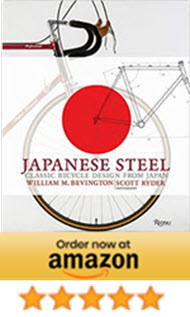Legacy of Japanese Engineering Excellence

Ultimate Japanese steel, another Zunow Hummingbird is this weeks Japanese bicycle of the Week. Initially in 1965, visionary craftsman Takeru Kageyama established Zunow in Uozu, Toyama Prefecture, subsequently revolutionizing Japanese bicycle manufacturing through advanced metallurgical processes.
this weeks Japanese bicycle of the Week. Initially in 1965, visionary craftsman Takeru Kageyama established Zunow in Uozu, Toyama Prefecture, subsequently revolutionizing Japanese bicycle manufacturing through advanced metallurgical processes.
Furthermore, his engineering philosophy seamlessly merged technical precision with artistic design, consequently establishing unprecedented standards in framebuilding methodology. Moreover, the innovative use of Japanese steel [2] in bicycle construction became fundamental to Zunow’s technical approach, particularly in their proprietary heat-treatment processes.

Advanced Frame Construction and Engineering
Primarily, the Zunow Hummingbird exemplifies precision engineering through its Japanese steel Chromoly frame construction. The 56cm frame features optimized geometry with a 33-inch stepover height, therefore delivering ideal weight distribution and handling characteristics.
Additionally, the frame angles, specifically engineered at 72.5-degree head tube and 73.5-degree seat tube, consequently create a responsive yet stable riding platform.

The Japanese steel [4] tubing specifications include:
- Triple-butted Chromoly walls: 0.9mm/0.6mm/0.9mm
- Investment cast dropouts with 7mm thickness
- Bottom bracket shell diameter: 68mm English thread
- Advanced lug work with 0.4mm cut windows
- Tire clearance: 28mm maximum width
- Cable routing: Internal through top tube (1.2mm housing)
Metallurgical Analysis and Material Properties
The premium Japanese steel alloy composition features:
- Carbon content: 0.25-0.35%
- Chromium: 0.8-1.1%
- Molybdenum: 0.15-0.25%
- Manganese: 0.4-0.7%
- Ultimate tensile strength: 850-950 MPa
- Yield strength: 750-800 MPa
- Elongation rate: 12-15%

Component Integration and Performance Features
Subsequently, the Shimano 600 groupset, manufactured with comparable Japanese steel standards, includes:
Front Derailleur Specifications:
- Parallelogram design: 8mm total movement
- Spring tension: 2.5N/mm
- Cage width: 32mm maximum chainring differential
Rear Derailleur Technical Data includes:
- Maximum sprocket size: 28T
- Total capacity: 39T
- Pulley wheel diameter: 11mm
- Parallelogram pivot tolerance: 0.1mm

Crankset Engineering features:
-
- 52/42T chainrings (6061-T6 aluminum)
- 172.5mm arm length
- BCD: 130mm
- Q-factor: 145mm

“Experience Italian craftsmanship at your fingertips – premium Castelli cycling gloves now 40% off.” LEARN MORE
Consequently, the Japanese steel construction methods ensure precise alignment through:
- Digital gauge verification (±0.02mm tolerance)
- Laser alignment for dropout spacing
- Cold-setting procedures for chainstay profile
- Proprietary lug-cutting templates

Japanese Steel Advanced Manufacturing Facility Specifications
Furthermore, the Japanese steel [8] frame production facility maintained strict environmental controls:
- Temperature stability: 20°C ±1°C

- Relative humidity: 45% ±5%
- Air filtration: HEPA class H13
- Lighting: 1000 lux at workstation level
- Static control: Conductive flooring with 1MΩ resistance
- Clean room classification: ISO Class 7

Additionally, the brazing station specifications include:
The brazing station maintains precise temperature control within ±5°C while continuously monitoring oxygen levels for optimal joint formation. The system features automated flux application and utilizes a 45% silver content brazing alloy, ensuring consistent joint strength. Additionally, the facility maintains a fume extraction rate of 1000m³/hour and implements digital temperature logging for quality assurance.
Enhanced Quality Control Procedure
Moreover, each Japanese steel [9] frame undergoes systematic verification:

Japanese Steel Alignment Protocol:
- Three-plane digital measurement
- Laser interferometry verification
- Digital angle gauging
- Surface plate comparison
- Cold-setting validation
Surface Finish Testing:
Each frame undergoes rigorous surface finish analysis, including microscopic inspection at 50x magnification and standardized paint adhesion testing following ASTM D3359 protocols. The validation process incorporates comprehensive corrosion and impact resistance testing, while UV stability confirmation ensures long-term finish durability.
including microscopic inspection at 50x magnification and standardized paint adhesion testing following ASTM D3359 protocols. The validation process incorporates comprehensive corrosion and impact resistance testing, while UV stability confirmation ensures long-term finish durability.

Detailed Frame Building Process
Subsequently, the Japanese steel [10] tubing preparation includes:
- Precision mitering to ±0.1mm tolerance
- End facing at 90° ±0.5°
- Internal butting verification
- Surface preparation protocol
- Stress relief treatment
Lug Preparation Process:
- Window cutting precision: ±0.2mm
- Internal shoreline profiling
- Point filing to 0.3mm radius
- Investment casting verification
- Shore hardness testing
Contemporary Market Position and Legacy
Meanwhile, while modern materials have evolved, vintage Japanese steel frames like this Hummingbird maintain their significance through documented production methods and verified material certification. Additionally, complete build documentation and period-correct components enhance collectibility.

Engineering Excellence and Performance Legacy
Finally, this Japanese steel [12] masterpiece represents uncompromising engineering precision. Through material selection and advanced manufacturing processes, the Zunow Hummingbird created an enduring standard of cycling excellence.
The combination of refined metallurgy, component integration, and meticulous attention to detail ensures this bicycle’s position as a significant piece of cycling heritage.
 |
 |
We earn from qualified Amazon purchases with NO cost to you. ANY item that you need or were going to purchased anyway through any of our links, helps support this site. Thank you for your support!
If you enjoyed learning about this week’s featured bicycle, don’t miss out on some cycling information you can use and enjoy! Visit our website at pacelinebikes.com Plus, check out our YouTube channel, Bicycle Restoration Man, for detailed restoration videos and showcases of our finished projects. Subscribe and join our community of bike enthusiasts!
